

Pole weapon. A selection of polearms, mostly halberds.
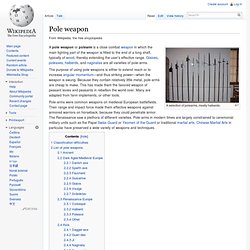
The purpose of using pole weapons is either to extend reach or to increase angular momentum—and thus striking power—when the weapon is swung. Because they contain relatively little metal, pole-arms are cheap to make. This has made them the favored weapon of peasant levies and peasants in rebellion the world over. Many are adapted from farm implements, or other tools. Pole-arms were common weapons on medieval European battlefields. Classification difficulties[edit] Quarterstaff. A quarterstaff (plural quarterstaves), also short staff or simply staff is a traditional European pole weapon and a technique of stick fighting, especially as in use in England during the Early Modern period.
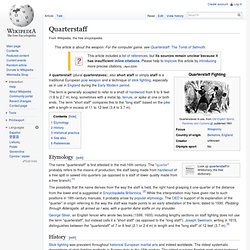
Etymology[edit] The name "quarterstaff" is first attested in the mid-16th century. The "quarter" probably refers to the means of production, the staff being made from hardwood of a tree split or sawed into quarters (as opposed to a staff of lower quality made from a tree branch).[1] The possibility that the name derives from the way the staff is held, the right hand grasping it one-quarter of the distance from the lower end is suggested in Encyclopædia Britannica. [2] While this interpretation may have given rise to such positions in 19th-century manuals, it probably arose by popular etymology.
History[edit] Stick fighting was prevalent throughout historical European martial arts and indeed worldwide. Historical practice[edit] Spear. Modern reproductions of a medieval European spear and a series of javelins.
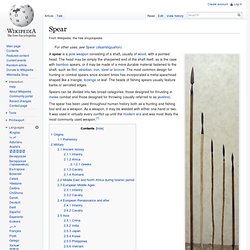
The heads are hand forged steel, the shafts are made from Ash wood. A spear is a pole weapon consisting of a shaft, usually of wood, with a pointed head. The head may be simply the sharpened end of the shaft itself, as is the case with bamboo spears, or it may be made of a more durable material fastened to the shaft, such as flint, obsidian, iron, steel or bronze. The most common design for hunting or combat spears since ancient times has incorporated a metal spearhead shaped like a triangle, lozenge or leaf. The heads of fishing spears usually feature barbs or serrated edges. Spears can be divided into two broad categories: those designed for thrusting in melee combat and those designed for throwing (usually referred to as javelins). Javelin. A depiction of a javelin thrower on an ancient Greek vase, ca. 450 BC.
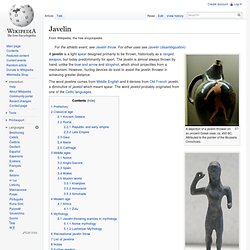
Attributed to the painter of the Brussels Oinochoes. Javelin thrower. Bronze, Laconian style, third quarter of the 6th century BC A javelin is a light spear designed primarily to be thrown, historically as a ranged weapon, but today predominantly for sport. The javelin is almost always thrown by hand, unlike the bow and arrow and slingshot, which shoot projectiles from a mechanism. Pilum. Pilum Design[edit]
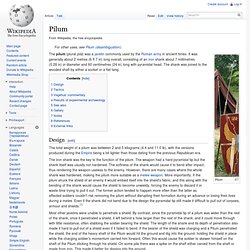
Yari. Three su yari mounted in koshirae, including one with an asymmetrical crossbar (hadome) Yari (槍?)
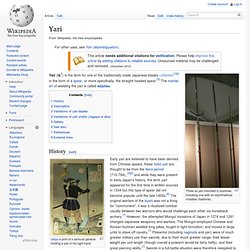
Pike. A modern recreation of a mid-17th century company of pikemen.
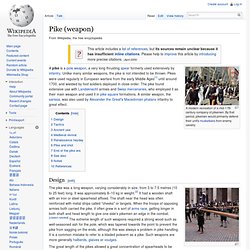
By that period, pikemen would primarily defend their unit's musketeers from enemy cavalry. A pike is a pole weapon, a very long thrusting spear formerly used extensively by infantry. Unlike many similar weapons, the pike is not intended to be thrown. Pikes were used regularly in European warfare from the early Middle Ages[1] until around 1700, and wielded by foot soldiers deployed in close order.
The pike found extensive use with Landsknecht armies and Swiss mercenaries, who employed it as their main weapon and used it in pike square formations. The pike was a long weapon, varying considerably in size, from 3 to 7.5 metres (10 to 25 feet) long. First rank with pikes at "charge for horse" static defensive posture, ready to draw swords if needed. First rank with pikes at "charge", second rank holding pikes at "port". A common misconception is that pikes were employed for use against cavalry.
Military fork. Military fork, ca. late 16th - early 17th century.
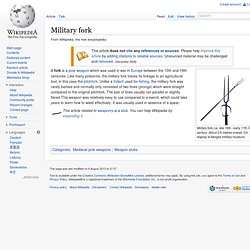
About 2.5 metres overall. On display at Morges military museum. Military Fork (pole arm) Military Fork (pole arm), Continental, c. 16th-17th century From: The Complete Encyclopedia of Arms & Weapons From: Stone's Glossary Return to Bernard Levine's Knife Related Links page.
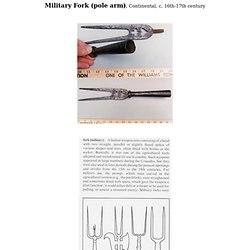
Trident. = The word "trident" comes from the French word trident, which in turn comes from the Latin word tridens or tridentis: tri "three" and dentes "teeth".

Sanskrit trishula is compound of tri त्रि "three" + ṣūla शूल "thorn". The Greek equivalent is τρίαινα (tríaina), from Proto-Greek trianja (threefold). The trident in the Coat of Arms of Ukraine is known as Tryzub (Тризуб), the literal translation of "trident". Uses[edit] Mosaic, 4th century BC, showing a retiarius or "net fighter", with a trident and cast net, fighting a secutor. Fountain of Neptune in Diafáni, Karpathos island. Ranseur. Types of ranseur, 16th century. Spetum. Italian folding spetum, c. 1550 Detail of folding spetum. Partisan. Bec de corbin. Lucerne hammer. Man with Lucerne hammer, 18th century.
The Lucerne hammer is a type of polearm which was popular in Switzerland during the 15th to 17th centuries. It was a combination of the bec de corbin with the blunt war hammer. The name comes from a discovery of many of these weapons in Lucerne, Switzerland.[1] The 'hammer' was actually a three- to four-pronged head mounted atop a 2m-long (7 foot) polearm stick. It bore a long spike on its reverse, and an even longer spike extending from the very top.
It proved effective at puncturing or smashing armor, and much like a man catcher was used for dismounting riders. References[edit] Jump up ^ Oakeshott, Ewart (1980). External links[edit] Spotlight: The Medieval Poleaxe, by Alexi Goranov. Voulge. Voulges A voulge (occasionally called a pole cleaver) is a type of polearm that existed alongside the similar glaive in medieval Europe. Superficially, a voulge might strongly resemble a glaive, but there are some notable differences in construction. First, the attachment of the voulge blade to the shaft was usually done by binding the lower two thirds of the blade to the side of the pole; the glaive would often have a socket built into the blade itself and was mounted on top of the pole. In addition, while both had curved blades, that of the voulge was broad and meant for hacking, while that of the glaive was narrow and meant more for cutting. Dane Axe. Replica Danish axe head, Petersen Type L or Type M, based on original from Tower of London.
Bardiche. Glaive. Glaives. Bill. Naginata. Samurai with naginata. Guan dao. Woldo. The Woldo (literally “moon blade”), was a Korean pole weapon that closely resembled the Chinese guandao (also known as yanyuedao), though proportionally smaller. It was so named because of its curved blade. Halberd. Lochaber axe. Polearms and Basket-hilted claymores in the Great Hall of Edinburgh Castle.